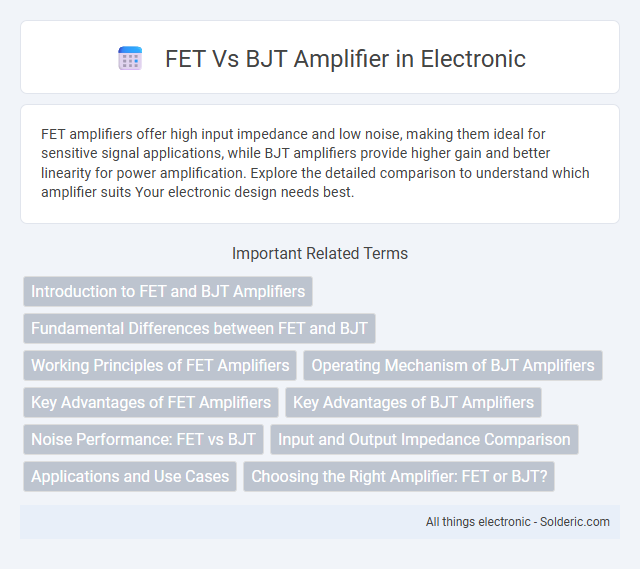FET amplifiers offer high input impedance and low noise, making them ideal for sensitive signal applications, while BJT amplifiers provide higher gain and better linearity for power amplification. Explore the detailed comparison to understand which amplifier suits Your electronic design needs best.
Comparison Table
| Feature | FET Amplifier | BJT Amplifier |
|---|---|---|
| Full Name | Field Effect Transistor | Bipolar Junction Transistor |
| Control Type | Voltage-controlled device | Current-controlled device |
| Input Impedance | High (10^6 to 10^12 O) | Low to Moderate (10^3 to 10^5 O) |
| Noise Level | Low noise | Higher noise compared to FET |
| Gain | Moderate gain | High gain |
| Linearity | Good linearity | Moderate linearity |
| Thermal Stability | Better thermal stability | Less thermal stability |
| Power Consumption | Lower power consumption | Higher power consumption |
| Applications | Input stages, high impedance amplifiers | Output stages, high gain amplifiers |
Introduction to FET and BJT Amplifiers
Field Effect Transistor (FET) and Bipolar Junction Transistor (BJT) amplifiers serve as essential components in electronic signal amplification, each with distinct operating principles. FET amplifiers utilize voltage-controlled channels for high input impedance and low noise, making them suitable for sensitive signal processing. BJT amplifiers function through current-controlled junctions, offering high gain and faster response, ideal for robust amplification tasks in various electronic circuits.
Fundamental Differences between FET and BJT
Field Effect Transistors (FETs) differ from Bipolar Junction Transistors (BJTs) primarily in their operation principles, with FETs being voltage-controlled devices and BJTs being current-controlled devices. FETs exhibit high input impedance and low noise, making them ideal for high-frequency and sensitive applications, whereas BJTs provide higher gain and better drive capabilities due to their lower output impedance. The unipolar conduction mechanism in FETs contrasts with the bipolar conduction in BJTs, influencing their linearity, switching speed, and thermal stability.
Working Principles of FET Amplifiers
FET amplifiers operate by using an electric field to control the conductivity of a semiconductor channel, where the voltage applied to the gate terminal regulates the current flow between the source and drain terminals. This voltage-controlled mechanism ensures high input impedance and low noise, making FET amplifiers ideal for voltage amplification in sensitive circuits. Understanding the working principles of FET amplifiers helps you optimize signal integrity and achieve greater efficiency in electronic designs.
Operating Mechanism of BJT Amplifiers
BJT amplifiers operate by using the base-emitter voltage to control the current flowing between the collector and emitter terminals, enabling voltage amplification. The input signal modulates the base current, which causes a proportionally larger variation in the collector current due to transistor gain (b). You can achieve high current gain in BJT amplifiers because the transistor relies on charge carrier injection and majority carrier conduction in its bipolar junction structure.
Key Advantages of FET Amplifiers
FET amplifiers offer high input impedance, resulting in minimal signal loading and superior voltage gain compared to BJT amplifiers. Their low noise generation makes them ideal for sensitive electronic circuits, ensuring clearer signal amplification. You benefit from the thermal stability of FETs, which reduces distortion and enhances overall amplifier performance.
Key Advantages of BJT Amplifiers
BJT amplifiers offer higher current gain and better linearity compared to FET amplifiers, making them ideal for applications requiring precise signal amplification. They provide superior transconductance, resulting in improved voltage amplification and faster switching speeds. Your choice of amplifier can benefit from BJTs' robust performance in low-frequency and high-gain circuits.
Noise Performance: FET vs BJT
FET amplifiers exhibit lower noise performance compared to BJT amplifiers due to their higher input impedance and reduced flicker noise, making them ideal for low-level signal amplification. BJTs generate more thermal noise because of their higher transconductance and lower input impedance, which can degrade signal integrity in sensitive applications. In ultra-low noise systems, FETs are preferred for minimizing input-referred noise and maintaining signal fidelity.
Input and Output Impedance Comparison
FET amplifiers typically exhibit high input impedance, often in the megaohms range, making them ideal for interfacing with high-impedance sources without significant signal loss. In contrast, BJT amplifiers have lower input impedance, usually in the kiloohms range, which can load the previous stage more heavily. Output impedance of BJTs tends to be lower than that of FETs, enabling better driving capability for low-impedance loads and improving overall signal transfer in your amplifier design.
Applications and Use Cases
FET amplifiers excel in high-frequency applications and low-noise environments due to their high input impedance and low gate current, making them ideal for RF circuits, sensitive sensor interfaces, and impedance buffering. BJT amplifiers are preferred in applications requiring high gain and fast switching, such as audio amplification, power amplification, and analog signal processing. Your choice depends on whether you need low noise and input loading (FET) or higher current drive and gain (BJT) for specific electronic designs.
Choosing the Right Amplifier: FET or BJT?
Choosing the right amplifier depends on your specific application requirements, as FET amplifiers offer high input impedance and low noise, making them ideal for sensitive signal amplification. BJT amplifiers provide higher gain and better frequency response, which is suitable for applications requiring strong signal boosting. Consider factors like input impedance, noise level, gain, and frequency response to determine whether a FET or BJT amplifier best fits your design needs.
FET vs BJT amplifier Infographic

 solderic.com
solderic.com